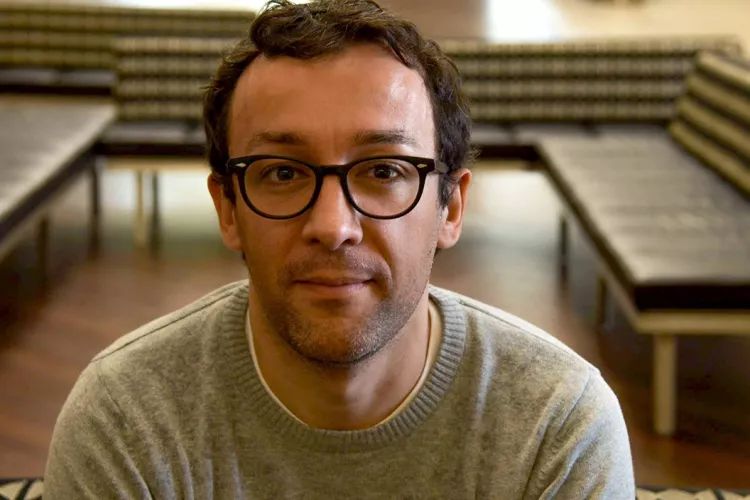Now a Department, Spanish Delivering Meaningful Student Experiences

Associate Professor Luciano Martínez (above), now chair of the department, and María-Luisa Guardiola, professor of Spanish, worked for many years to establish Spanish as a department, which came to fruition in 2019. Photo credit: Alina Jara-Yupanqui
When Associate Professor Luciano Martínez announced in spring 2019 that Spanish was becoming its own department at Swarthmore, it was met with a mix of delight and surprise.
“Many of our students grew up in bilingual homes, and others have been studying Spanish since childhood,” says Martínez. “Spanish is not ‘foreign’ to them: It is part of their lives. That is why it was so personal for many of them. It was a very joyous moment.”
Adds Salima Bourguiba ’19, who majored in economics and Spanish: “It truly never occurred to me that it wasn’t already a department, because it always felt like one.”
“From the richness of the materials we covered in class, to the hands-on knowledge that those of us who were fortunate enough to participate in study trips acquired,” she says, “the faculty always went to great lengths to ensure every student felt catered for on a personal level.”
Still, as the Spanish program grew within the Modern Languages and Literature Department, it became increasingly difficult to manage. Therefore, Martínez, now chair of the new department, and María-Luisa Guardiola, professor of Spanish, worked for many years to establish Spanish as a department — improving learning goals and assessment, honing the structure of the curriculum, finding smarter models of teaching intensive Spanish language courses, and more.
These efforts culminated in May 2019, when the College’s Council on Educational Policy gave its recommendation for Spanish to become a department, which Swarthmore faculty overwhelmingly voted to support.
“It was an organic transformation,” Guardiola told The Phoenix, but still a significant undertaking. Martínez rewrote language syllabi, changed all of the language textbooks, and altered the structure of language courses, while the department added two new instructors. The faculty also worked to promote literature courses taught in English, to dispel the notion that they offer courses in only the Spanish language.
Specialization is key: Instructors of the department’s language classes have been trained to teach Spanish as a second language, and all faculty have the time and space to develop courses in their areas of expertise.

“Learning Spanish at Swarthmore has allowed me to not only develop a fluency for the language but feel culturally competent,” says Jacob Clark ’21.
“This allows us to teach courses in English, contribute to interdisciplinary programs, and make our courses available to a broader student population,” says Nanci Buiza, associate professor of Spanish, whose offerings include Civil Wars and Neoliberal Peace in Central America.
The faculty have also made introductory and upper-level courses interdisciplinary, compatible with courses in Black studies, interpretation theory, gender & sexuality studies, and other subjects. These changes allow the department to devote all of its energy to responding to the varied and evolving needs of students, strengthening curricular and pedagogical methods, and enhancing the sense of community, says Martínez.
The results have been encouraging. There’s been a sharp increase in students (including Clare Cushing ’20) combining Spanish with another major, such as biology or engineering. Current students and recent graduates have obtained Fulbright fellowships; undertaken grad studies in law, medicine, education, and more; and explored an array of worlds through study abroad.
The latter aligns with the department’s desire for students to be able to communicate fluently in Spanish, with a nuanced understanding of the literatures and cultures of Spain, Latin America and the Caribbean, and Latinos in the U.S., says Martínez. The goal is a vibrant community of Spanish learners and speakers on campus.
“The faculty are extremely committed to that, and each of my classes has reflected this energy,” says Sam Jacobson ’22, an Spanish and political science major from Columbia, Md., who was inspired to study abroad in Buenos Aires, Argentina, and analyze Latin American governance with Associate Professor of Political Science Sam Handlin.
Andrew Estella ’21 drew upon his Spanish experience at Swarthmore for internships with a local district attorney’s office and the Securities and Exchange Commission.
“The high level of Spanish that the department prepared us with proved instrumental,” says the Spanish and economics major from Hopkinton, Mass.
Adds Jacob Clark ’21, a Spanish and linguistics major from Fenton, Mich., who spent a year in Madrid, Spain, tutoring children in elementary Spanish, advanced Spanish, and Latin American literature: “Learning Spanish at Swarthmore has allowed me to not only develop a fluency for the language but feel culturally competent” when interacting with communities for which Spanish is the dominant language.
Also leaning strongly on his Spanish education from Swarthmore is Jun Rendich ’19, who recently started a position assisting research at Dartmouth College on remote delivery of mental health services.
“Not only language skills but also understanding of historical context and cultural humility has proven endlessly useful,” says Rendich, who majored in philosophy and minored in Spanish. “I am grateful for these skills that transfer to so many different fields and disciplines.”
The faculty delight in these and other outcomes for their students/graduates, as well as those of their colleagues, such as Désirée Díaz, assistant professor of Spanish, receiving support from the President’s Fund for Racial Justice for her course this spring on the Politics of Latinx Art and Activism.
But they do so with their eyes to the future, says Martínez, with the U.S. quickly becoming the second-largest Spanish-speaking country in the world.
“Once again, we will be required to reinvent ourselves to address the needs of our students,” he says.



